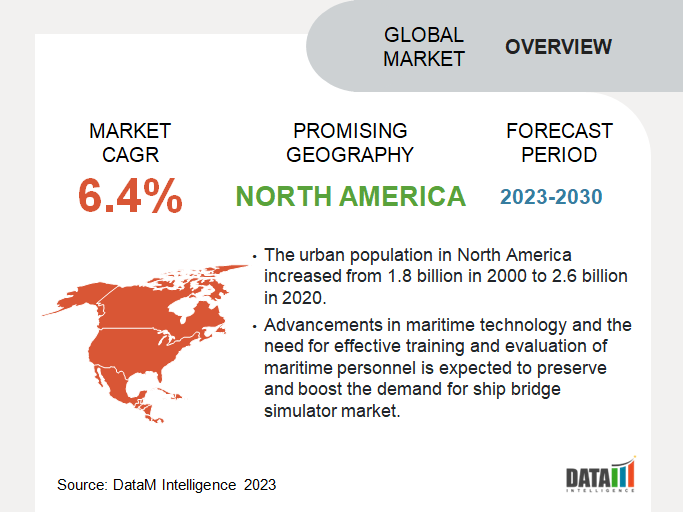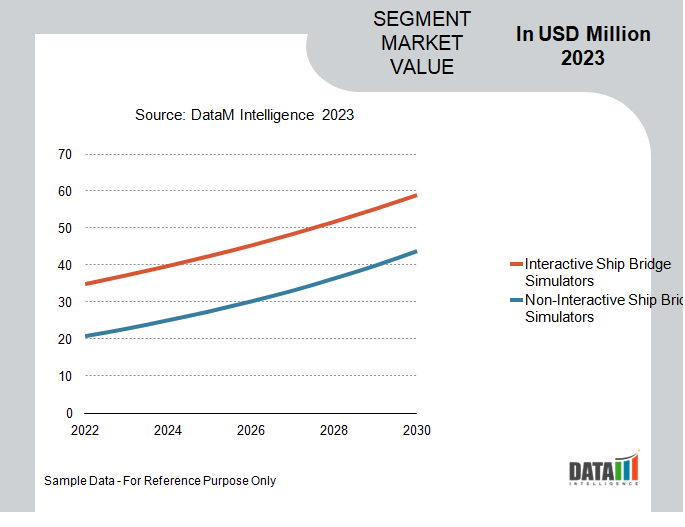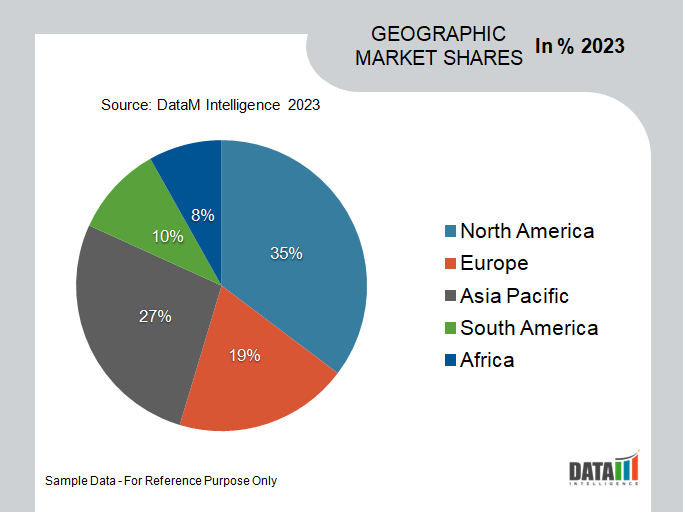Global Ship Bridge Simulator Market is segmented By Type (Interactive Ship Bridge Simulators, Non-Interactive Ship Bridge Simulators), By Solution (Live Training, Professional Training, Constructive Training, Virtual Training, System Training, Game Simulation Training), By Organization Size (Large Scale Organizations, Medium Scale Organizations, Small Scale Organizations), By End-User (Marine, Educational), and By Region (North America, South America, Europe, Asia Pacific, Middle East, and Africa) – Share, Size, Outlook, and Opportunity Analysis, 2023-2030
Market Overview
Global Ship Bridge Simulator Market reached US$ 2.2 billion in 2022 and is expected to reach US$ 3.1 billion by 2030, growing with a CAGR of 6.4% during the forecast period 2023-2030.

The global ship bridge simulator market is witnessing robust growth, driven by the rising demand for efficient training solutions, stringent safety regulations, and increasing seaborne trade activities. As ship bridge simulators continue to evolve and become more sophisticated, they will play a pivotal role in enhancing crew competence and maritime safety.
The future of the global ship bridge simulator market looks promising, with the adoption of simulation technology expected to become even more widespread. Advancements in artificial intelligence (AI) and virtual reality (VR) are likely to revolutionize the simulation experience, making it more immersive and personalized. However, the high initial cost of installing ship bridge simulators remains a key restraint, particularly for small and medium-sized shipping companies.
The interactive ship bridge simulators segment takes the lead in the type segment, showcasing rapid growth and capturing more than 50% of the market share. The remarkable expansion can be attributed to technological advancements and an increasing emphasis on maritime safety. Similarly, North America dominates the ship bridge simulator system market, holding the largest market share of over one-third. The region presents significant potential in this market, driven by advancements in maritime technology and the demand for effective training and evaluation of maritime personnel.
Market Scope
|
Metrics |
Details |
|
CAGR |
6.4% |
|
Size Available for Years |
2021-2030 |
|
Forecast Period |
2023-2030 |
|
Data Availability |
Value (US$) |
|
Segments Covered |
Type, Solution, Organization Size, End-User and Region |
|
Regions Covered |
North America, Europe, Asia-Pacific, South America and Middle East & Africa |
|
Fastest Growing Region |
North America |
|
Largest Region |
North America |
|
Report Insights Covered |
Competitive Landscape Analysis, Company Profile Analysis, Market Size, Share, Growth, Demand, Recent Developments, Mergers and Acquisitions, New Product Launches, Growth Strategies, Revenue Analysis, Porter’s Analysis, Pricing Analysis, Regulatory Analysis, Supply-Chain Analysis and Other key Insights. |
For More Insights Download Sample
Market Dynamics
Safety and Risk Mitigation as well as Regulatory Compliance Requirements
Safety remains a top priority in the maritime industry. Accidents at sea can have catastrophic consequences, including loss of life, environmental damage, and financial losses. Ship bridge simulators play a crucial role in enhancing safety and risk mitigation by providing realistic training for ship crews in various weather conditions, navigational challenges, and emergency scenarios.
According to data from the International Maritime Organization (IMO), ship accidents have declined over the past decade, partially attributed to the widespread adoption of advanced simulation-based training. Ship bridge simulators enable crew members to practice collision avoidance, handling emergencies, and maneuvering in challenging environments, leading to more competent and confident seafarers.
Further, the maritime industry is subject to stringent regulations and standards set by international bodies such as the IMO. Compliance with these regulations is vital for the safety and environmental protection of the oceans and seas. Ship bridge simulators aid in meeting these regulatory requirements by offering comprehensive training and certification programs for maritime professionals.
Data from the United States Coast Guard (USCG) shows that ship bridge simulator training is a mandatory requirement for seafarers seeking various certifications and licenses. The respective fact mandates the use of simulators for training purposes, driving the demand for advanced simulation systems in the maritime industry.
Growing Maritime Industry and Associated Need for Cost-Effective Training
The global maritime industry is witnessing significant growth, driven by increased international trade, offshore exploration, and rising demand for energy resources. The respective expansion in the maritime sector is creating a demand for well-trained and competent seafarers, further fueling the adoption of ship bridge simulators.
Data from United Nations Conference on Trade and Development (UNCTAD) reveals that seaborne trade has been steadily increasing over the years, with more than 80% of the world's goods being transported by sea. The surge in maritime activity necessitates skilled mariners, leading to a surge in the demand for ship bridge simulator training to produce qualified professionals.
Traditional onboard training for ship crews can be time-consuming and expensive. Ship bridge simulators offer a cost-effective alternative by providing a controlled and repeatable training environment. Crew members can undergo various training scenarios without the need for a physical ship, reducing operational costs and minimizing risks associated with onboard training.
According to the Maritime and Port Authority of Singapore (MPA), the adoption of ship bridge simulators has led to substantial cost savings for training institutions and ship operators. Moreover, the ability to conduct training onshore allows for more frequent and consistent training sessions, leading to better-prepared crews and improved operational efficiency.
High Initial Investment and Technological Limitations
The lack of standardization in ship bridge simulator training programs is another restraint affecting the market's growth. While several maritime authorities and organizations provide guidelines and recommendations for simulator training, there is no globally accepted standard for simulator training syllabi and assessment criteria.
The lack of uniformity can lead to inconsistencies in the quality and effectiveness of training programs, undermining the credibility of the simulator-based training approach. As per data from the United States Coast Guard (USCG), there are no universal standards for ship bridge simulator training, resulting in varied approaches and methodologies adopted by different training institutes. The respective creates challenges for maritime officers seeking certification or endorsement of their simulator training, and it can impact the overall market growth as potential customers may become skeptical about the training's reliability.
Moreover, despite the rapid advancements in simulation technology, ship bridge simulators still face certain limitations that restrain their full potential. For instance, some simulators may not accurately replicate the complex interactions between the ship and the surrounding environment, leading to less realistic training scenarios. Furthermore, the complexity of integrating real-world data, such as weather conditions and traffic patterns, into simulator systems poses technical challenges that can hinder the seamless execution of training exercises.
Data from the European Maritime Safety Agency (EMSA) highlights the importance of addressing technological limitations in ship bridge simulators. EMSA emphasizes the need for continuous research and development efforts to improve the fidelity and realism of simulation systems, ensuring that they provide effective training experiences for maritime personnel.
Segmentation Analysis
The global ship bridge simulator market is segmented based on type, solution, organization size, end-user and region.

Ability of drip irrigation to address the challenges of water scarcity and improving agricultural productivity
The drip irrigation segment within the global ship bridge simulator system market has been experiencing substantial growth in recent years. Drip irrigation systems are widely recognized for their water-saving capabilities and efficient water delivery directly to the plant's root zone. The technology is playing a crucial role in addressing the challenges of water scarcity and improving agricultural productivity. Solar-powered irrigation systems utilize solar energy to power water pumps, providing a sustainable and cost-effective solution for farmers, particularly in regions with limited access to electricity.
Solar-powered irrigation systems help reduce reliance on fossil fuels, decrease operational costs, and provide an environmentally friendly approach to irrigation. The drip irrigation segment is a significant contributor to the growth of the ship bridge simulator system market. Drip irrigation offers several advantages over conventional irrigation methods, such as reduced water consumption, improved nutrient delivery, minimized soil erosion, and enhanced crop yield. Such benefits have led to the widespread adoption of drip irrigation systems, driving market growth.
Geographical Penetration
Booming Maritime Industry in North America and Rising Emphasis on Safety and Training Standards

North America is home to some of the world's busiest and most strategic ports, making it a vital hub for international maritime trade. Ports like Los Angeles, Long Beach, New York-New Jersey, and Vancouver handle massive cargo volumes, facilitating global supply chains and trade networks. According to the United States Census Bureau, the total value of U.S. imports and exports amounted to US$ 4.9 trillion in 2020. The thriving maritime trade has fueled the demand for highly skilled and well-trained marine personnel, driving the adoption of ship bridge simulators for efficient training and assessment.
The United States Coast Guard (USCG) and Transport Canada play crucial roles in promoting safety and setting high training standards in the maritime industry. Their regulations and guidelines mandate the use of ship bridge simulators for various training programs, including navigation and crisis management.
The USCG's Marine Safety Center (MSC) focuses on safety evaluation, research, and development of maritime technologies, including simulation systems. By emphasizing the use of advanced simulators, they ensure the competency and preparedness of maritime professionals to handle complex and challenging scenarios.
Ship Bridge Simulator Companies and Competitive Landscape
The major global players in the market include Wärtsilä, Rheinmetall AG, General Dynamics Information Technology, Inc., AVEVA Group plc, Presagis Canada Inc., ST Engineering, BMT Group Ltd, ARI Simulation, PC Maritime and FORCE TECHNOLOGY.
COVID-19 Impact On Ship Bridge Simulator Market
The COVID-19 pandemic significantly impacted the global ship bridge simulator market, causing disruptions in training schedules, financial constraints, and delays in simulator installations. The pandemic-induced economic slowdown caused financial constraints for many maritime companies and institutions.

Budget cuts and reduced spending on non-essential items, including simulator installations and upgrades, affected the ship bridge simulator market's revenue streams. With supply chain disruptions and restrictions on non-essential services, the delivery and installation of ship bridge simulators faced delays during the pandemic.
However, as the maritime industry looks to recover and adapt to the new normal, there are opportunities for growth in areas such as safety-focused training, technological advancements, hybrid training solutions, and competency assessment tools. Government support and intervention will play a crucial role in driving the market's recovery and facilitating the adoption of simulator-based training methods.
As the industry recovers, there will be an increased focus on safety and training, leading to a higher demand for ship bridge simulators to enhance crew competency and preparedness. The ship bridge simulator market's ability to innovate and meet the changing training needs of the maritime sector will determine its resilience and success in a post-pandemic world.
Key Developments
- On June 20, 2023, Wärtsilä partnered with NSB Group to upgrade the simulators in the latter’s NSBacademy. The new simulators by Wärtsilä will incorporate an updated edition of the Navi-Trainer professional simulation software, along with the latest NACOS PLATINUM Bridge systems.
- On April 18, 2023, Wärtsilä, a leading technology group, has been chosen to provide advanced simulation training equipment for a new maritime educational center developed by Swedish shipping company, Furetank.
- On October 8, 2020, IIT-Madras announced the launch of a new 360-degree full bridge ship simulator to prevent sailors, pilots and captains from traveling to UK or Singapore to achieve training.
Why Purchase the Report?
- To visualize the global ship bridge simulator market segmentation based on type, solution, organization size, end-user and region, as well as understand key commercial assets and players.
- Identify commercial opportunities by analyzing trends and co-development.
- Excel data sheet with numerous data points of ship bridge simulator market-level with all segments.
- PDF report consists of a comprehensive analysis after exhaustive qualitative interviews and an in-depth study.
- Product mapping available as excel consisting of key products of all the major players.
The global ship bridge simulator market report would provide approximately 69 tables, 61 figures and 192 Pages.
Target Audience 2023
- Manufacturers/ Buyers
- Industry Investors/Investment Bankers
- Research Professionals
- Emerging Companies